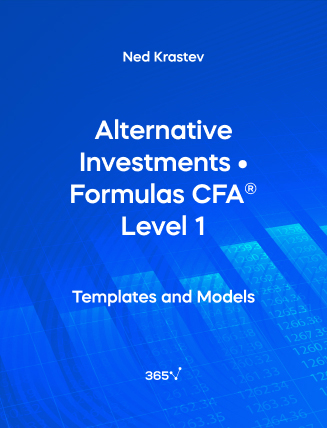Need an all-in-one list with the Alternative Investments formulas included in the CFA® Level 1 Exam? We have compiled them for you here. The relevant formulas have been organized and presented by chapter. In this section, we will cover the following areas — Leverage ratio, Volatility, Sharpe ratio, Sortino Ratio, Downside Risk, Discounted Cash Flow, Cap Rate, Funds from Operations, and NAV per share.
Leverage Ratio*
Leverage = \frac {Total~Debt}{Total~Equity}* This is one of several definitions and formulas for leverage, also known as Debt-to-Equity ratio
Volatility (standard deviation of returns) – population
σ = \sqrt {\frac {\sum_{i=1}^n (R{_i} - R{_{avg}})^2}{n}}R{_i} = Individual returns data points
R{_{avg}} = Average of all return data points in the set
n = Number of data points
Volatility (standard deviation of returns) – sample
σ = \sqrt {\frac {\sum_{i=1}^n (R{_i} - R{_{avg}})^2}{n-1}}R{_i} = Individual returns data points
R{_{avg}} = Average of all return data points in the set
n = Number of data points
Sharpe Ratio
Sharpe~Ratio = \frac {R{_p} - R{_f}}{σ{_p}}R{_p} = Portfolio return
R{_f} = Risk-free rate of return
σ{_p} = Standard deviation (volatility) of portfolio return
Sortino Ratio
Sortino~Ratio = \frac {R{_p} - R{_f}}{σ{_d}}R{_p} = Portfolio return
R{_f} = Risk-free rate of return
σ{_d} = Standard deviation (volatility) of the downside (“downside risk”)
Downside Risk (semi-deviation) – population
σ{_d} = \sqrt {\frac {\sum_{i=1}^n (R{_i} - R{_{treshold}})^2}{n}}R{_i} = Individual returns data points
R{_{treshold}} = Return threshold (determined by the user, for example the risk-free rate, hard target return or 0% can be used)
n = Number of data points
Downside Risk (semi-deviation) – sample
σ{_d} = \sqrt {\frac {\sum_{i=1}^n (R{_i} - R{_{treshold}})^2}{n-1}}R{_i} = Individual returns data points
R{_{treshold}} = Return threshold (determined by the user, for example the risk-free rate, hard target return or 0% can be used)
n = Number of data points
Discounted Cash Flow (DCF) = Net Present Value (NPV) of an investment
DCF = NPV = \sum_{t=0}^n \frac {CF_t}{(1 + r)^t}CF_t = Cash flow in time t
r = Discount rate
Capitalization Rate (Cap Rate)
Cap~rate = \frac {Net~Operating~Income~(NOI)}{Market~Value~(or~purchase~price~of~property)}Funds From Operations (FFO)
FFO = Net~Income + Depreciation~(and~other~non-cash~items) - Gains/Losses~from~property~sales~(and~other~non-recurring~items)
Adjusted Funds From Operations (AFFO)
AFFO = FFO-Recurring~Capital~Expenditures~(CAPEX)
Net Asset Value per share (NAV per share)
NAV~per~share = \frac {NAV}{Total~number~of~shares~outstanding}Follow the links to find more formulas on Quantitative Methods, Economics, Corporate Finance, Financial Reporting and Analysis, Portfolio Management, Equity Investments, Fixed-Income Investments, and Derivatives, included in the CFA® Level 1 Exam.

